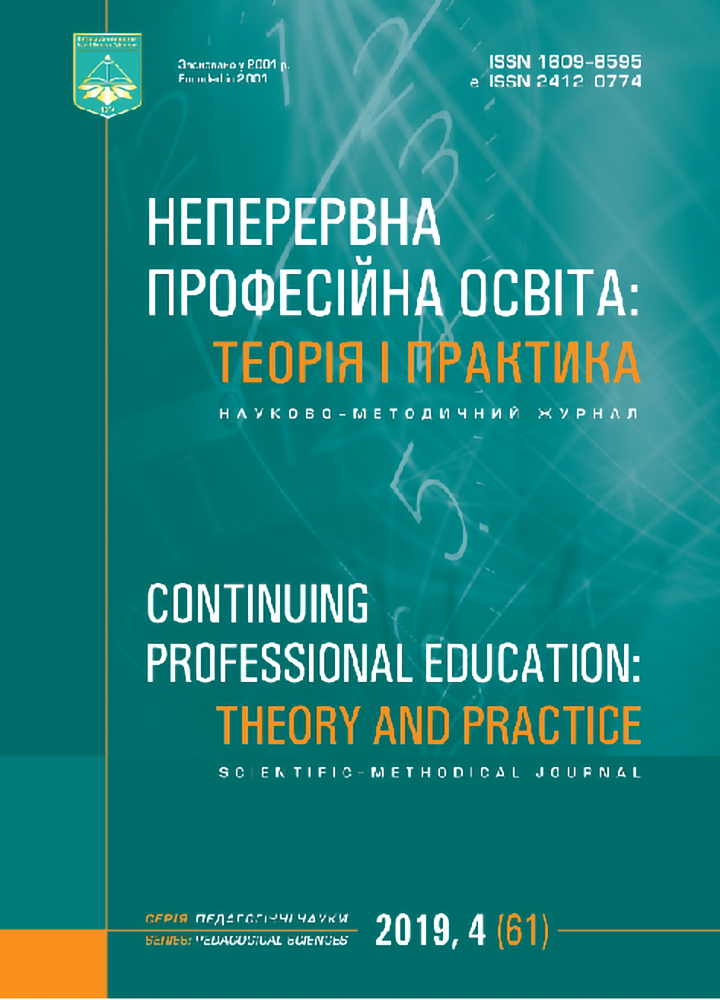INTERACTIVE METHODS IN COMMUNICATIVE EDUCATION
DOI:
https://doi.org/10.28925/1609-8595.2019.4.6873Keywords:
academic staff, communicative education, interactive methods and forms, learning, t e acher, teaching.Abstract
The article deals with the problem of using of interactive methods and forms of teaching, which are based on mutual learning, and community education. The empirical material of the research was collected by the method of questioning of academic staff from Ukrainian universities. The respondents were asked questions, grouped in 2 blocks. In the first block, the respondents had to pick up the interactive methods, which they use in teaching. The second block was a question about of the effectiveness of interactive methods. The results of the study made it possible to conclude that lecturers of Ukraine’s higher education institutions use interactive methods and forms of teaching for the communicative skills and competencies development, developing communicative personality traits and accumulation of professional and communicative experience, but their choice is not diverse and there is a lack of teachers’ knowledge about interactive methods and forms of teaching. These results contradict modern educational trends, which imply the activation, stimulation and encouragement of the activity of each student in the educational process.References
Blândul, V. C. (2015). The Role and Status of Didactic Communication in Educational Activity. Procedia – Social and Behavioral Sciences, 191, 2568–2572. DOI: 10.1016/j.sbspro.2015.04.584 (eng).
Bologna with Student Eyes (2015). Retrieved from https://www.esu-online.org/wp-content/uploads/2016/07/ BWSE-2015-online.pdf/ (eng).
Bulvinska, O. (2016). Communication-based formation of research competence by students of USA and European universities. Aktualnye problemy sovremennoj nauki: sbornik tezisov nauchnyh rabot HIII Mezhdunarodnoj nauchno-prakticheskoj konferencii (Moskow – Astana – Kharkov – Veinna, 28 oktyabrya 2016 goda) (pp.12–18). Moskow, Russia: Mezhdunarodnyj nauchnyj centr (eng).
Communication in the General Education Curriculum: A Critical Necessity for the 21st Century (2004). Washington, D. C., USA: National Communication Association (eng).
Hattie, J. A. C. (2009). Visible Learning. A synthesis of over 800 meta-analyses relating to achievement. New York, USA: Routledge (eng).
Morreale, Sh. P., Pearson, J. (2008). Why Communication Education is Important: The Centrality of the Discipline in the 21st Century. Communication Education, 57 (2), 224–240. DOI: 10.1080/03634520701861713 (eng).
Sysoieva, S. (2013). The concepts: interactive learning for adult learners. Continuing Professional Education: Theory and Practice, 3–4, 55–59 (eng).
Matyash, O. I. (2014). O neobhodimosti vvedeniya kommunikativnyh kursov i programm v rossijskih vuzah i o roli professionalnogo soobshestva [Toward implementing communicative curricula in russian universities and the role of the professional community]. Vestnik Novosibirskogo gosudarstvennogo universiteta, 13 (6), 62–69 (rus).
Proekt TYuNING – garmonizaciya osvitnih struktur u Yevropi [Tuning of educational structures in Europe] (2000). Retrieved from http://www.unideusto.org/tuningeu/images/stories/documents/General_Brochure_Ukrainian_ version.pdf (ukr).
Tyupa, V. (2012). Kommunikativnye parametry uroka v shkole konvergentnoj pedagogiki [Communicative lesson parameters in the school of convergent pedagogy]. Universum: Vestnik Gercenovskogo universiteta, 1, 56–66 (rus).
Downloads
Published
How to Cite
Issue
Section
License
Copyright (c) 2020 Oksana Bulvinska, Nataliia Khanykina

This work is licensed under a Creative Commons Attribution-NonCommercial 3.0 Unported License.



